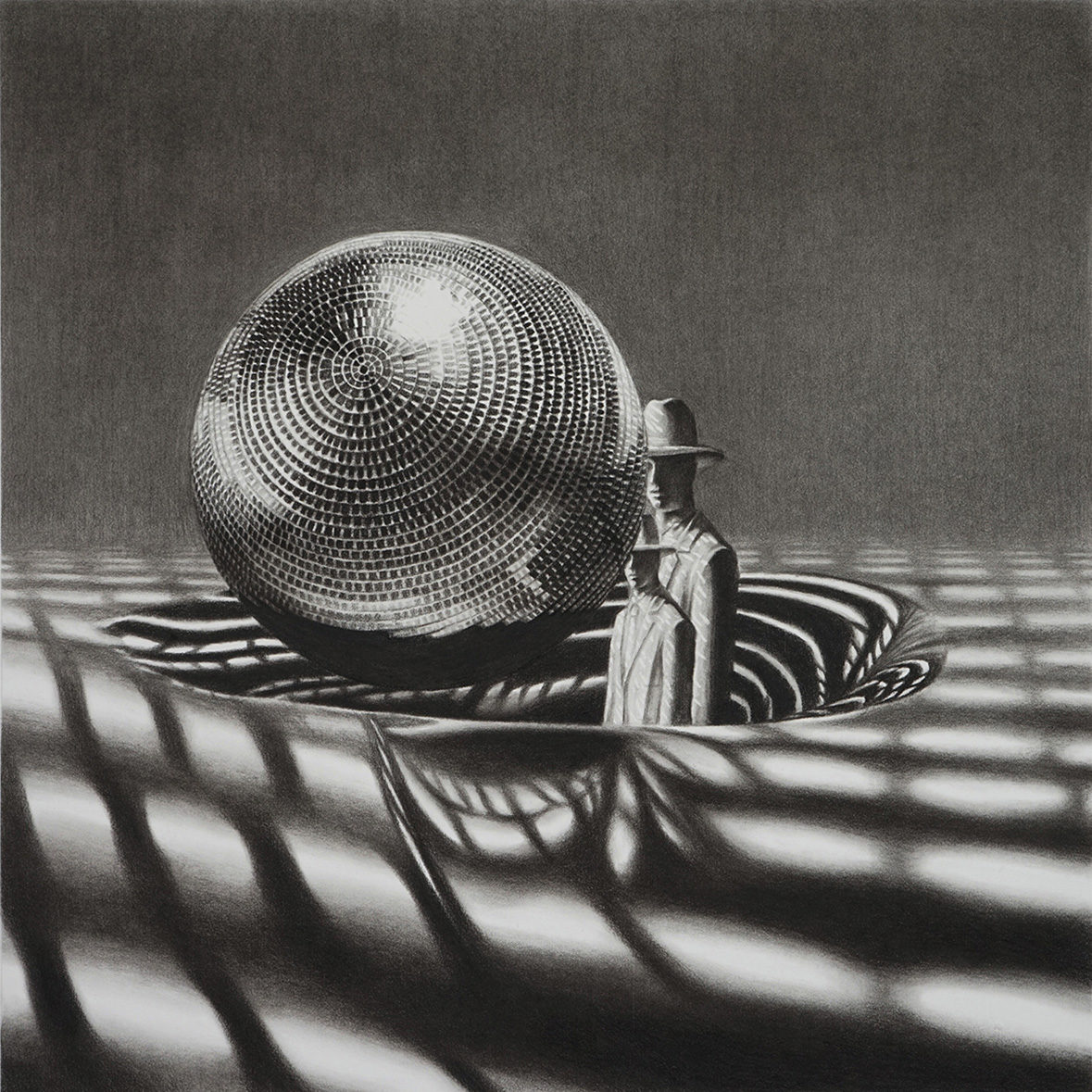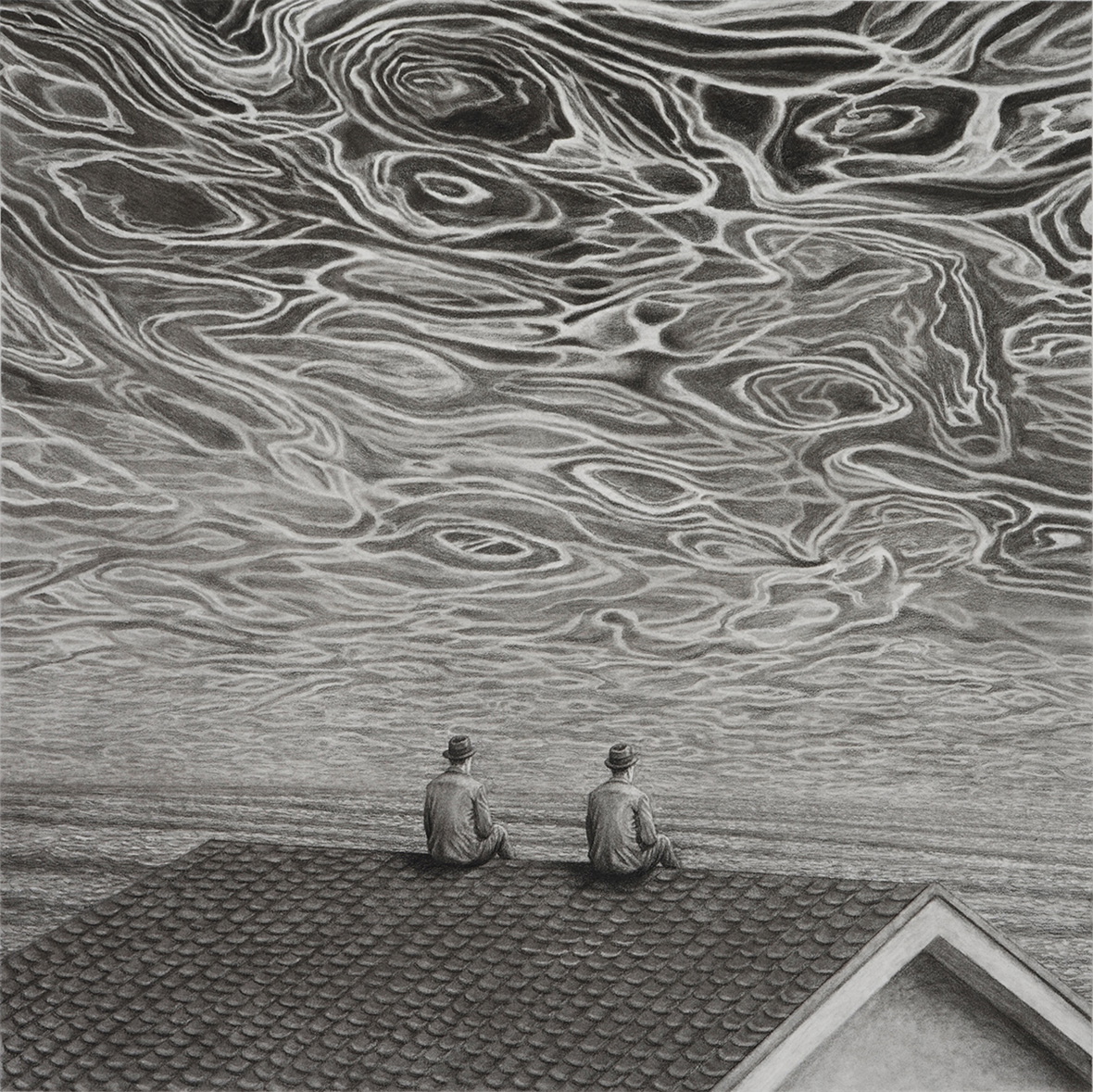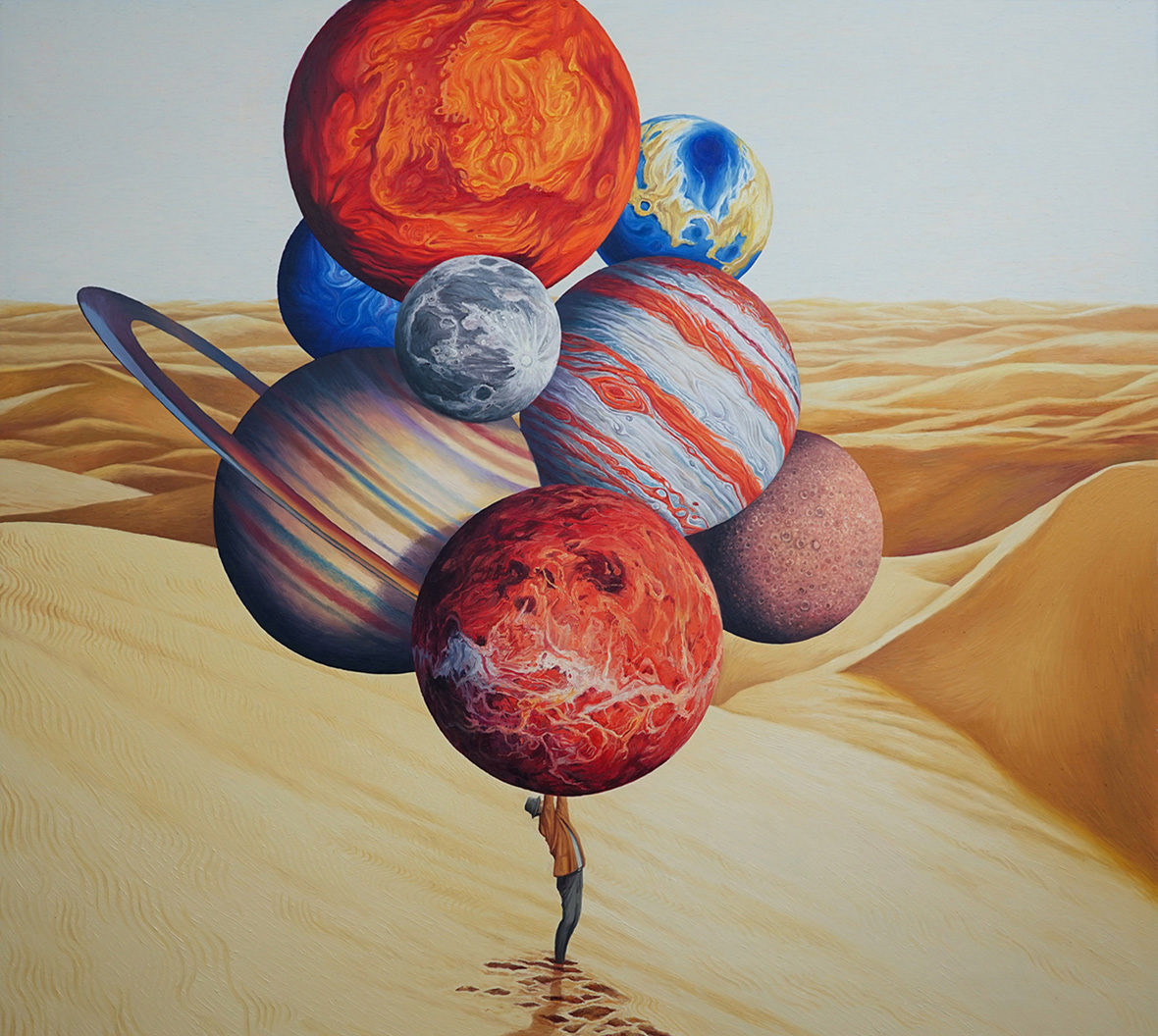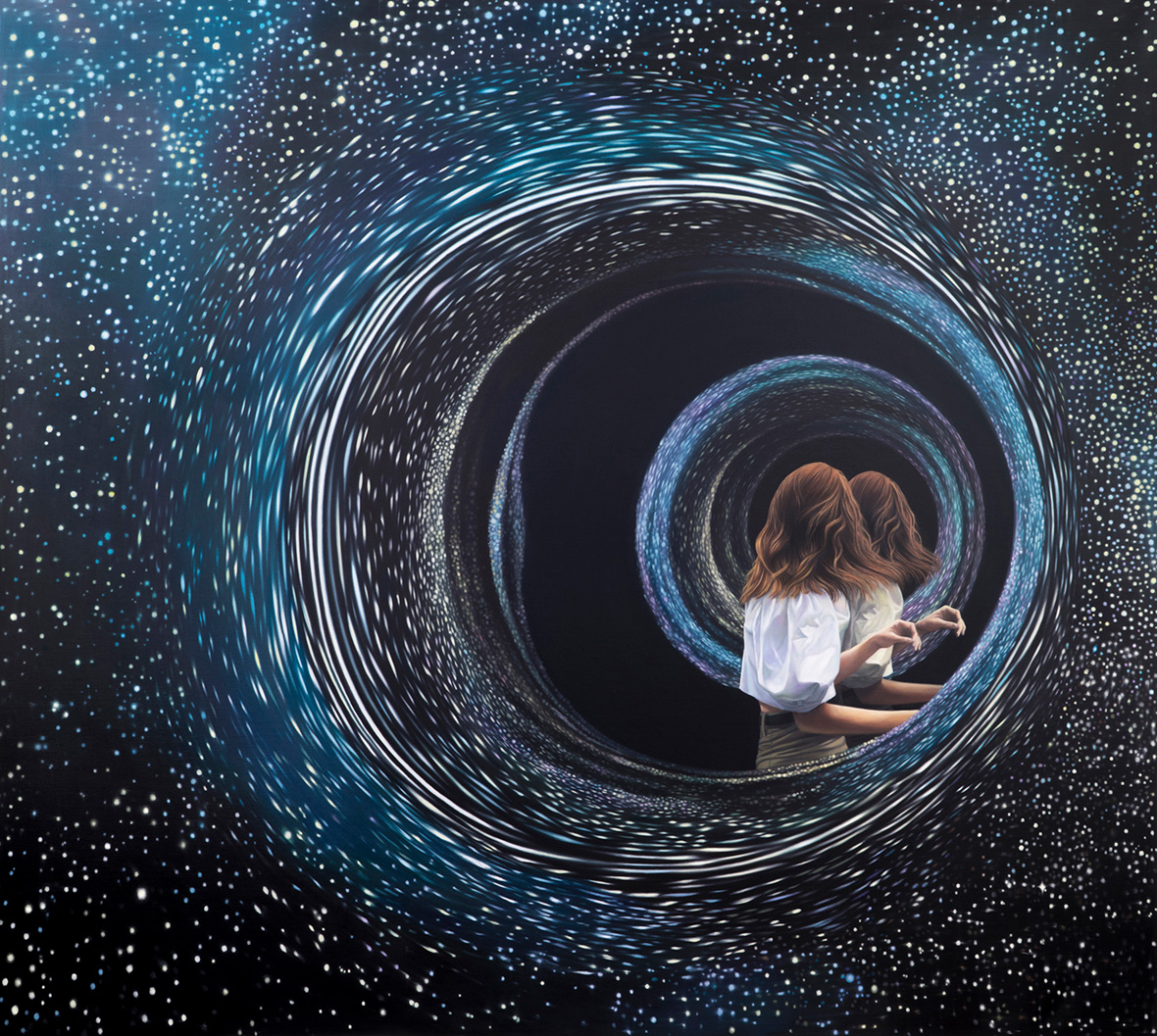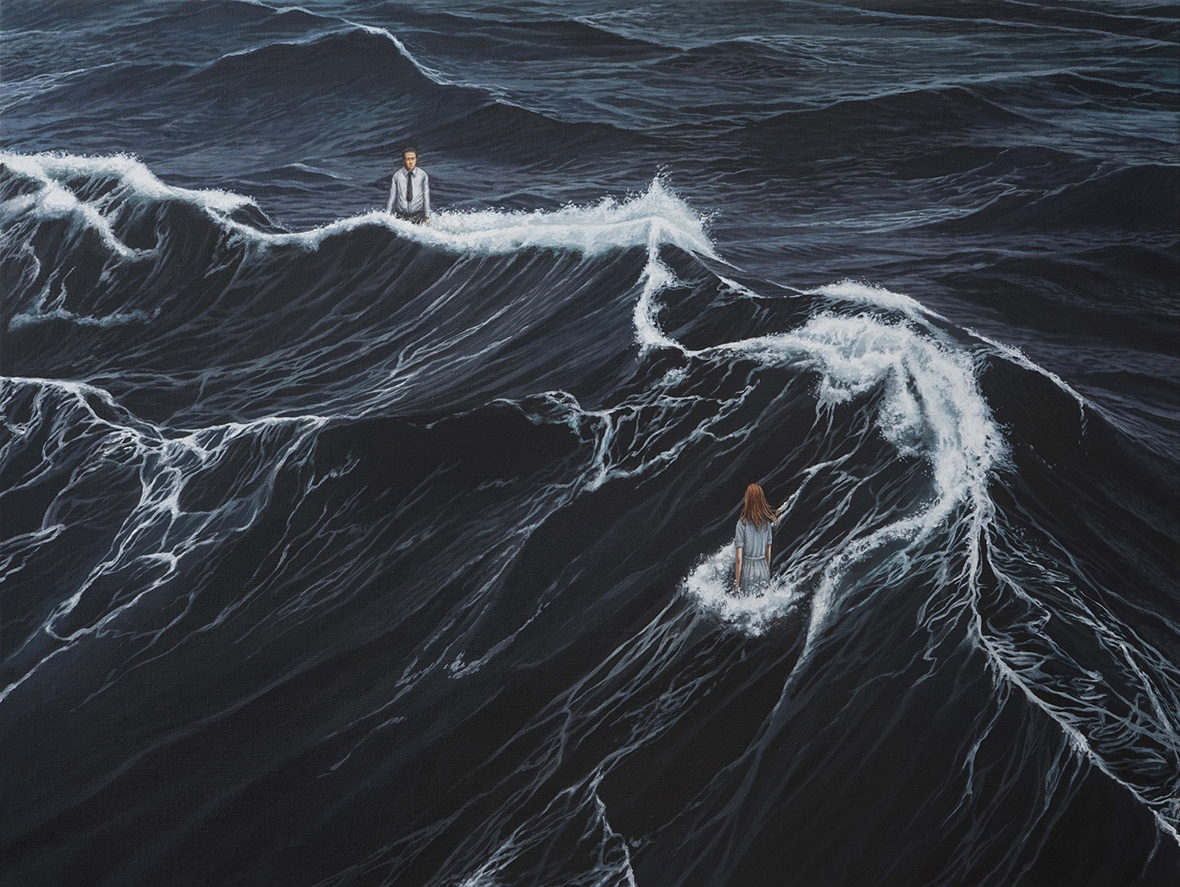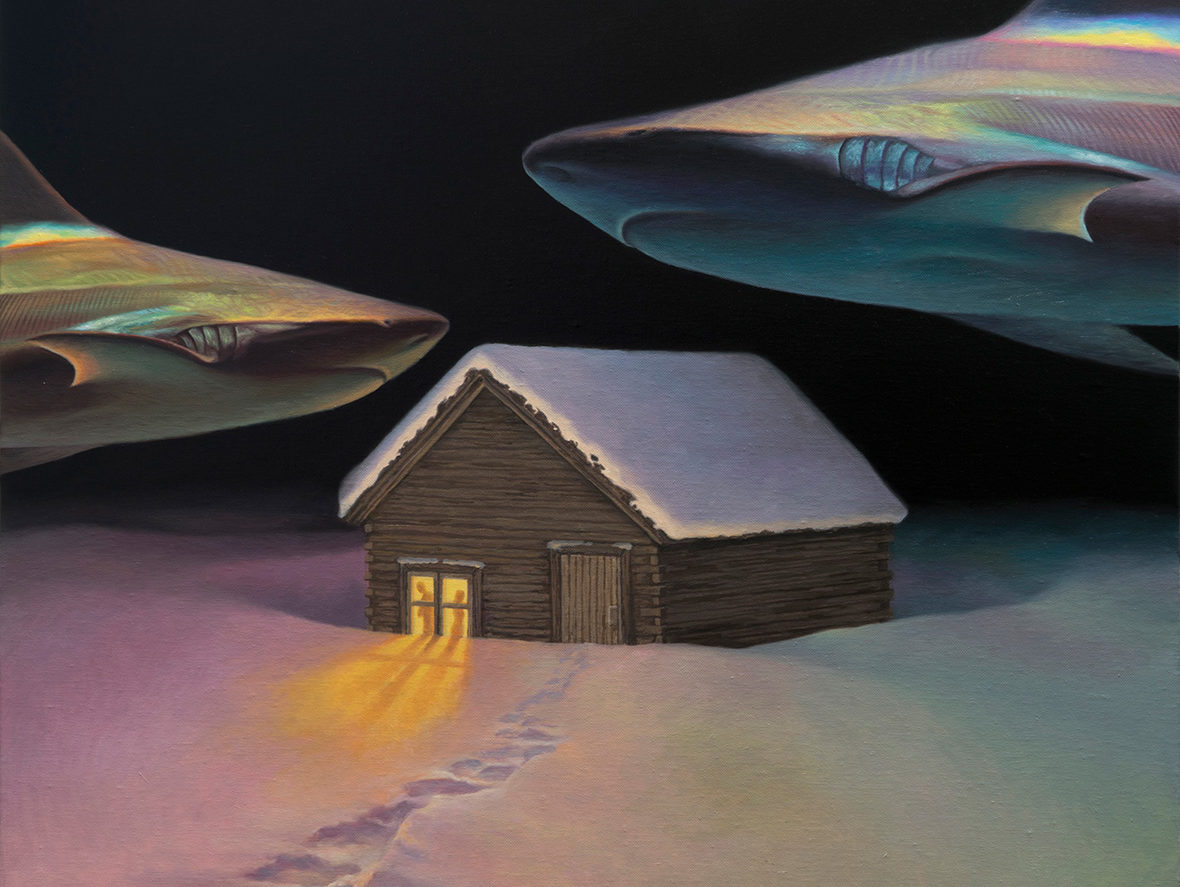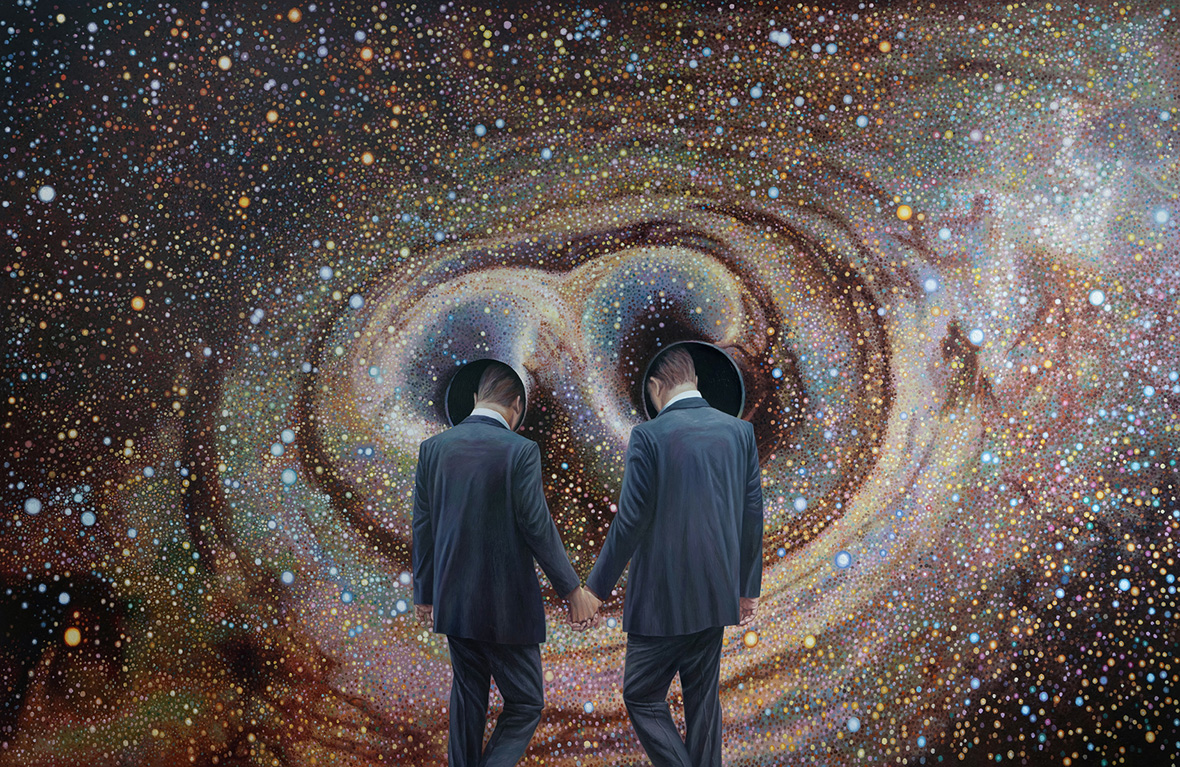
The book Red Sorghum earned Chinese author Mo Yan the Nobel Prize in Literature in 2012. In the novel, folk tales, history, and contemporary ideas are merged together in a “hallucinatory realism” that captures the imagination of readers. It was novels such as this and One Hundred Years of Solitude by Gabriel García Márquez that drove the unprecedented popularity of the literary genre magic realism in 1980s China. It is a genre that has allowed Chinese artists and writers to find new potential for their craft.
Shang Chengxiang creates magic-realistic paintings that take audiences on journeys through unparalleled wonders. With his works, he looks to visualize the hidden truths and desires of the unconscious mind. These sentiments can be manifested in dreams, a place where we all are able to assess what is happening in the deepest recesses of our subconscious. For Shang Chengxiang, dreams are a prism through which he conjures his fantastical.
Much of Shang’s work feels as if they’re produced through his stream of unconsciousness, with motifs and themes culled directly from the depths of a fantasy world. “In dreams, there are always unstable, vague emotions that you can’t identify for sure,” says Shang. “And those emotions are exactly what I look for.”
中国著名作家莫言于 1986 年出版的《红高粱家族》是一部融合了民间故事、历史和当代理念的 “幻觉现实主义”小说。其和加布里埃尔·加西亚·马尔克斯 (Gabriel García Márquez) 的《百年孤独》共同推动了魔幻现实主义在 80 年代中国的空前盛行,也正是这些文学体裁,让中国艺术家和作者挖掘出全新的创作潜力。
商成祥所创作的魔幻现实主义画作带领观众穿越奇观境地。他通过自己的作品,将人潜意识中隐藏的幻象描绘出来,其所带来的情往往只发生在梦中。通过梦境,人们能够了解自己潜意识的最深处。对商成祥来说,梦境是一面棱镜,折射着自己平日的幻想。
商成祥的大部分作品仿佛是在无意识的状态下创作完成,充满各种从幻想世界深处搜罗而来的元素和主题。他说:“梦是一种感知潜意识的方法,但梦境大多是你捉摸不定的会有一种隐约的模糊的情绪。我正是要通过创作抓住这种情绪。”
Many of Shang’s works more resemble photos than paintings, peppered with lifelike details. For example Immortality, which portrays a giant beating heart entombed within an underground vault. Perhaps it’s a metaphor for an unspoken love or it could be a story of having to conceal one’s feelings deep inside as a means of protecting themselves or a significant other. Maybe it’s simply rhetorical; Shang is always somewhat reluctant to reveal his full thoughts behind each artwork, leaving room for diverse interpretations and re-imaginations.
Born and raised in Shenyang, Shang witnessed the city fall from grace as a place of significance in China–it was a city synonymous with heavy industry and is now China’s rustbelt. This change in the city reflects the broken dreams of many of the inhabitants as their lives became more difficult. It also offers an explanation of Shang’s path towards magical realism; as his hopes and dreams for the city diminished so he began to tap into fantasies to express his frustrations.
他的许多作品逼真得更像是照片而非绘画,栩栩生动又充满细节。例如在《不朽》中所描绘的那颗藏于地下金库中的巨型心脏。这幅作品可比作一颗暗恋的心,也可能是在讲述一个为了保护自己或爱人而将感情埋藏于内心深处的故事;或可以被理解为单纯的强烈视觉表现。商成祥似乎不太愿意透露每件作品背后的全部想法,为观众留出更多解读和重新想象的空间。
商成祥从小在沈阳出生和长大,亲眼目睹这座中国北方城市从举足轻重的工业重镇到如今的没落景象。而城市的变迁也折射出当地居民梦想的瓦解,以及日益艰难的生活,渐渐影响了商成祥踏上魔幻现实主义的创作道路。幻想,成为他宣泄的方式。
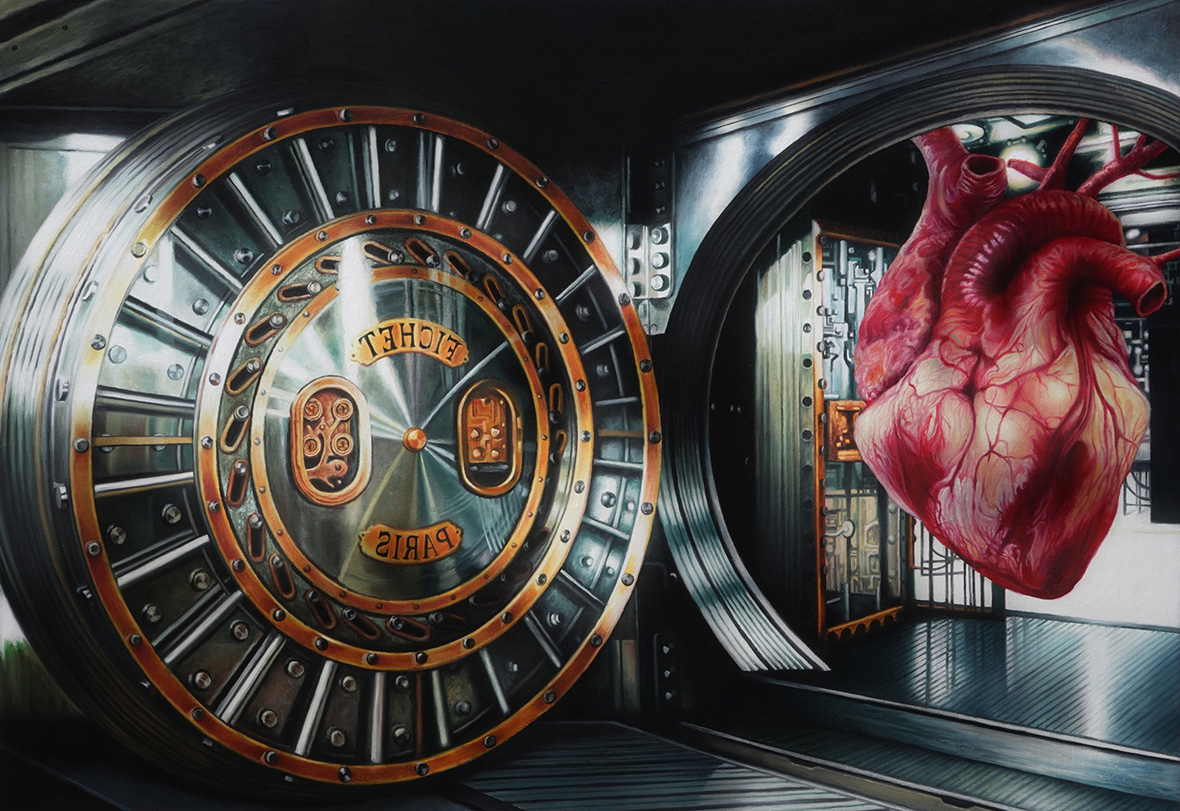
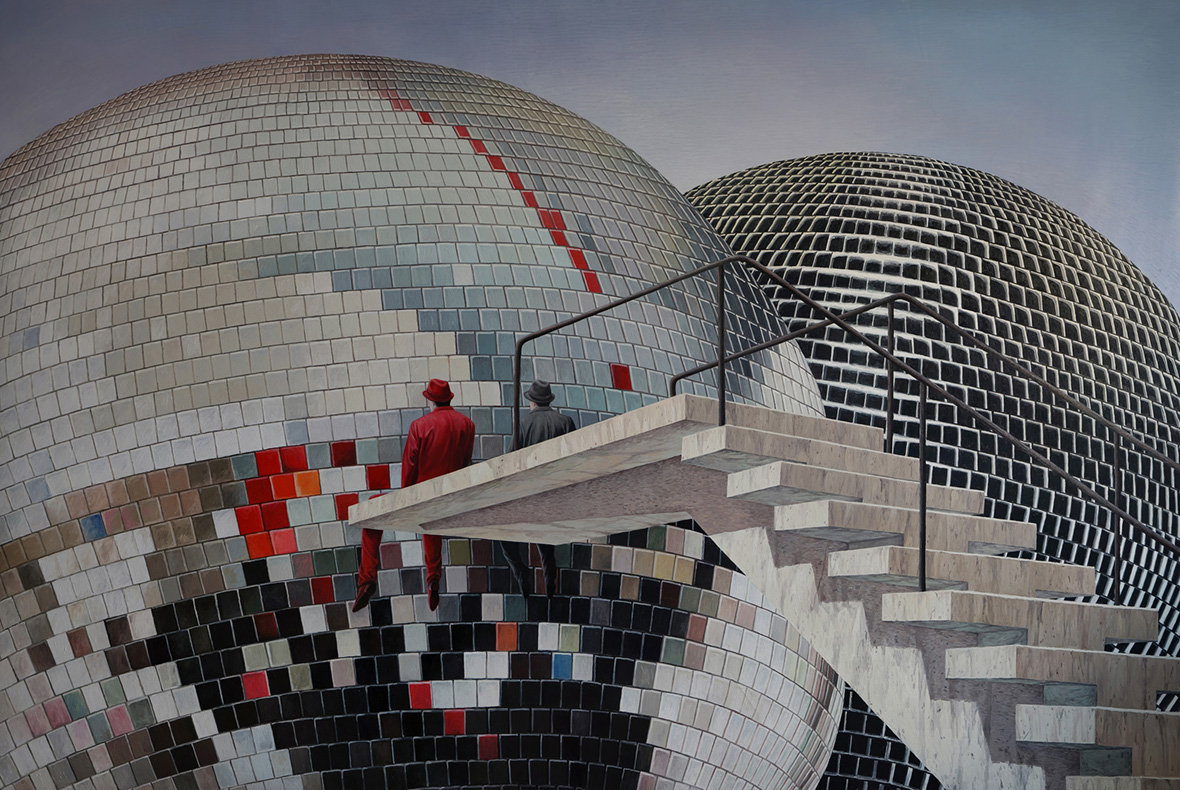
Shang’s paintings also evoke a sense of awe. His compositions have a realistic foundation in which he inserts surreal objects such as the giant globe-like disco balls in Borderless No. 1. Two figures with their backs to us sit atop some stairs that lead to these disco balls. Their legs dangle off the edge like children on a tall chair. But clearly, these are adults, their gender unclear from our vantage point as they sit with backs to the viewer and peer directly into the glimmering spheres.
His artwork focuses on underlying human emotions, leaving his audience with an elusive ambiguity. “My work contains lots of emotions,” says Shang. “I love to set up the suspense in my work which enables people to think.” Like all great art, his works ask viewers to reflect on the meaning of this to us as individuals and what it may represent to the artist himself; does it even matter what he intended it to mean if it makes us think about the world in a new light?
商成祥的画作能带给观众敬畏之感。他的作品以现实主义为基础,在此之上加入超现实主义的元素,例如《无界系列No. 1》中的巨大迪斯科球,画面中两个成年人坐在通往这些迪斯科球的楼梯上,双腿在边缘晃荡;他们背对着观众而坐,凝视着眼前巨大的发光球体。
商成祥的作品专注于探讨人类内心深处潜藏的情感,带给观众一种难以捉摸的模糊性。他说:“在我的作品中蕴含着很多的情绪。我喜欢制造这种悬而未决的氛围。”
和其他出色的艺术作品一样,商成祥的画作能勾起观众对自我和艺术家本人的思考;不过,如果一幅作品能让我们以新的眼光看待这个世界,原本的创作意图或仅供参考。
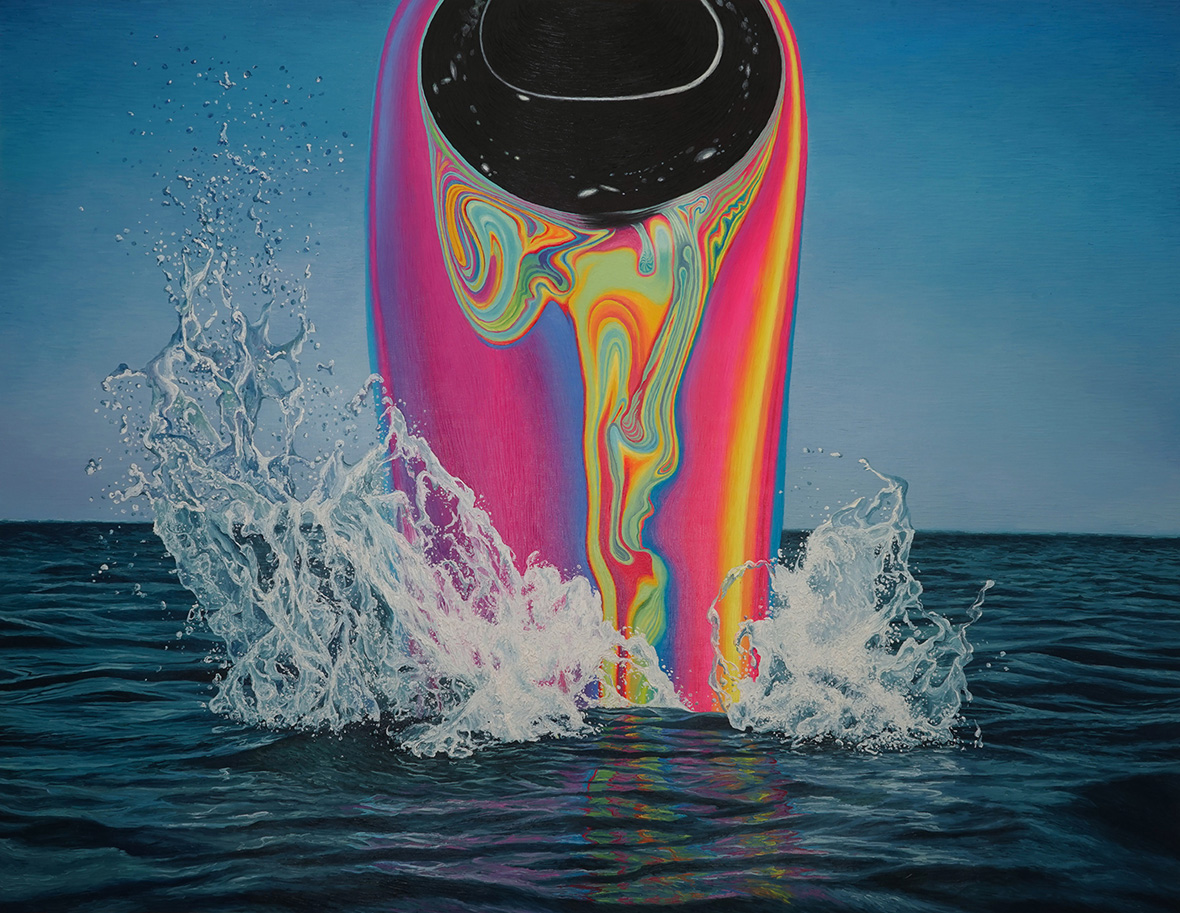
There are many recurring motifs in Shang’s work, such as the ocean and bodies of water. Water, and the sea specifically, he believes, evokes a sense of the unknown. Multiple Dimensions is characteristic of Shang’s use of the ocean as a metaphysical space of mystery. In the painting, a black hole-like void emerges from the sea, bursting through the surface pursued by a wondrous psychedelic color field. Juxtaposed against this fantasy-like imagery is the photorealistic quality of the water—a Shang signature throughout his oeuvre—the detail in the splashing water convincing the viewer that this scene is credible.
Then there are motifs of space and the cosmos, another recurring theme throughout his oeuvre. In Thoughtsn, viewers are presented with a swirling galaxy floating in the corridor of an apartment building. The door of a room is open with the spiral galaxy–reminiscent of Andromeda–seeming to emerge from it. The juxtaposition of this nebula in a confined space alludes to the endless possibilities of the cosmic dreams of unconsciousness.
商成祥的作品中有许多反复出现的元素,例如大海和水体。在他看来,水——尤其是大海——能唤起某种强烈的未知感。《多维世界》很好地体现了商成祥如何将海洋打造成神秘的形而上空间。画中,黑洞般的抽象物质从大海中涌现,裹挟多重迷幻性色彩。与这种虚幻相对应的,是商成祥作品的标志性特点——如照片般写真的海水,令整个场景逼近现实。
除此之外,空间和宇宙也是他经常在作品中运用的元素。在《第N次思考》中,璀璨星系漂浮于公寓的走廊。房门敞开,星系从房间里缓缓而来。星云与封闭空间的并列,暗示着个体意识中潜藏着无限的可能。
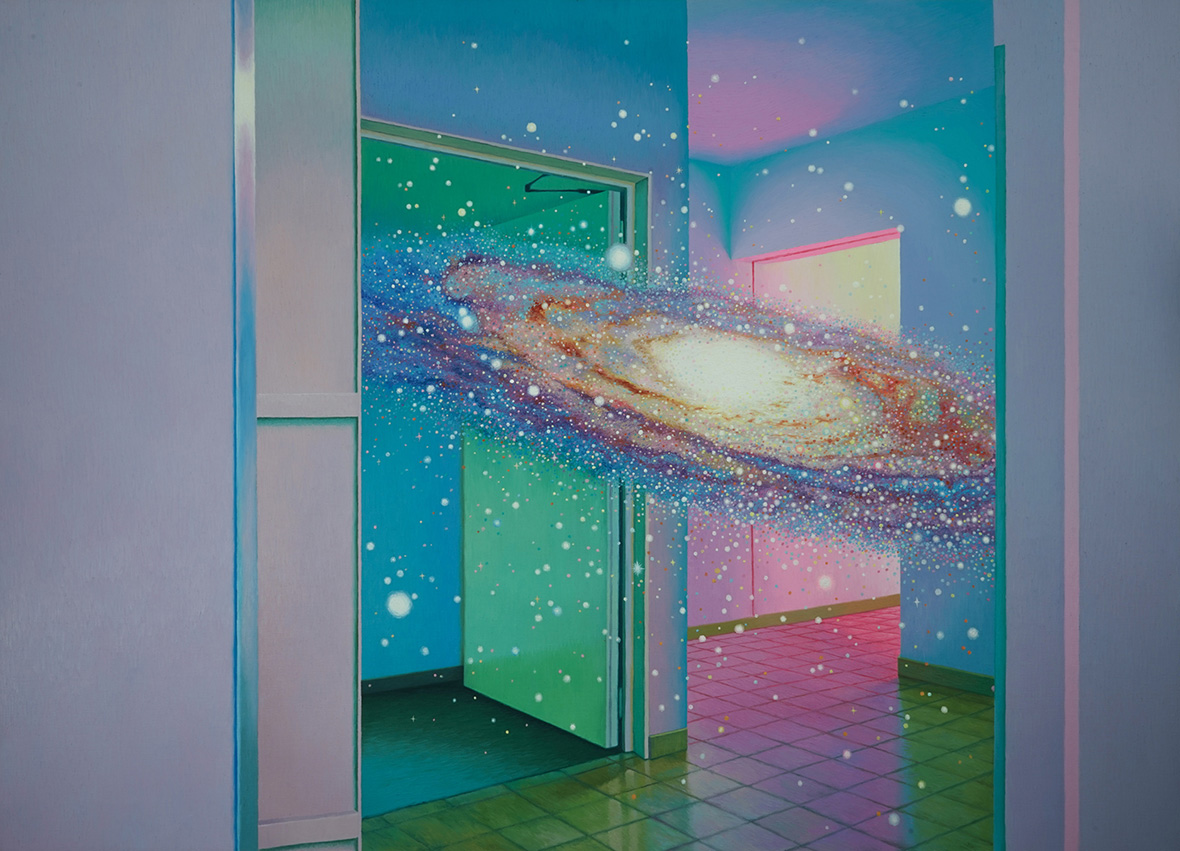
The diversity of the mediums he uses is another distinct feature of Shang’s work. “I like oil because I am used to painting thick and heavy then leaving tiny marks with a fine brush,” he explains. “In this way, my art feels freer.” In his most recent paintings, however, he has begun experimenting with other mediums.
We No. 1 uses acrylic paint and takes viewers below the ocean surface. Beneath waves, two reef sharks swim above a house covered in snow. Inside the window, two backlit figures stand with their backs to each other. Despite the subtlety of the body language, the standoff between the sharks aptly captures the tension between the pair within the cabin.
Shang uses watercolor on paper in The Way You Look No. 2, again featuring an ocean beast this time a humpback whale. Another anonymous female figure is involved; she is standing on a piece of dead sea coral reaching out and gently touching the whale. The sense between human and creature is peaceful and loving with an underlying sadness, the type of dream where you awake and almost want to cry but don’t know why.
另一个商成祥的创作特点是多样的创作媒介。他说:“油画材料目前是我比较喜欢的。我惯用厚重的颜料,令细节的描绘获得自由的发挥空间。”在自己最近的画作中,他又开始尝试其他全新的媒介。
《我们No.1》采用丙烯颜料创作。在海浪之下,埋藏着冰雪覆盖的小木屋,鲨鱼游离在其两端。透过窗户,两个人微弱的人影背朝着背。鲨鱼之间的对峙恰如其分地捕捉出木屋内两人之间的紧张气氛。而最近,他还尝试运用水彩。
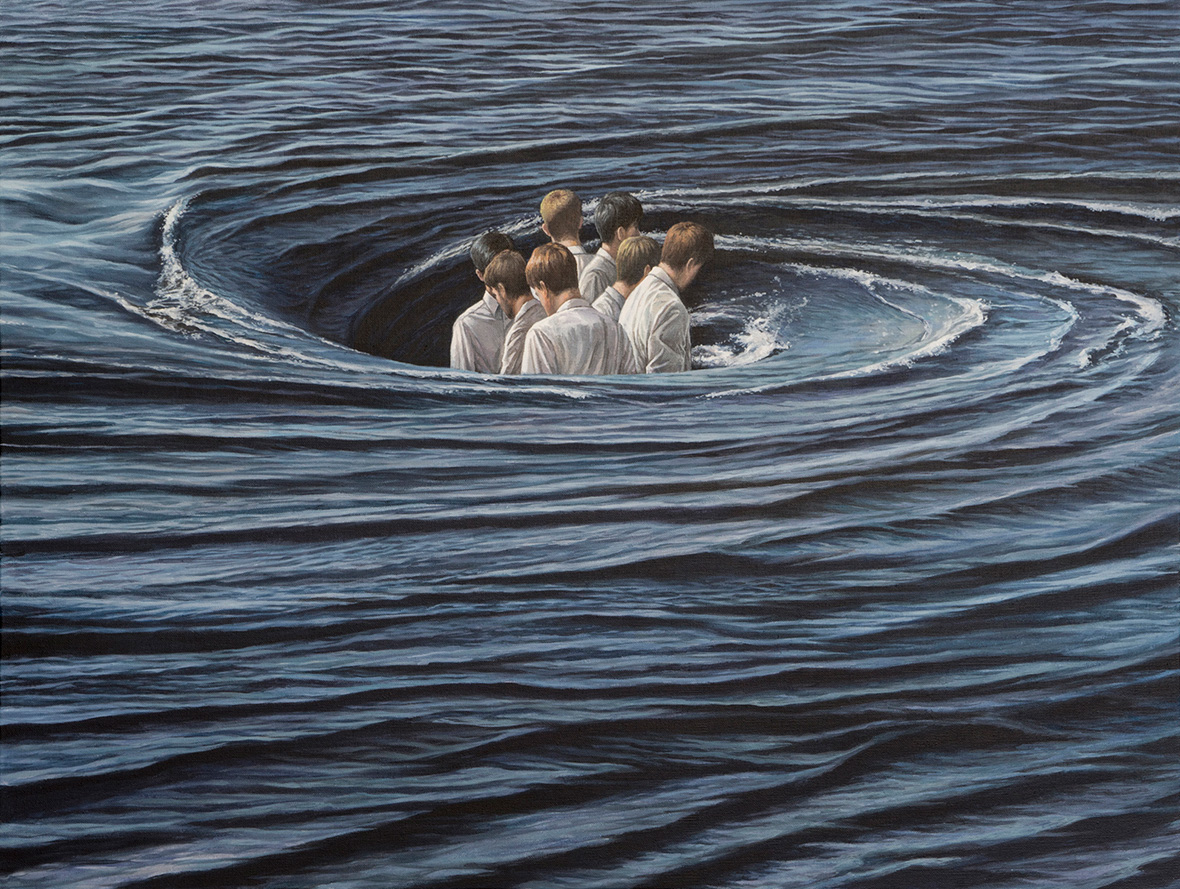
Shang Chengxiang’s latest works focus on the concept of space and time, with circular and spiral movements, and human thoughts and emotions held within this framework. Although seemingly ambiguous, his art draws viewers in and leaves them contemplating on the line between fantasy and reality. That is the beauty of his art: it is witty and thought-provoking yet also simply beautiful to look at.
His latest exhibition, Sunshine on Another Afternoon, is Shang’s third solo show at ART LABOR Gallery. This show delves deeper into his surrealist practice, including 19 new works, and brings the audience ever closer to the artist’s quest to uncover the mysteries of the universe.
商成祥的最新作品着眼于空间和时间的概念,描绘了各种圆形和螺旋状的动态,以及在此范畴内的各种思想和情感。虽然作品的含义看似摸不着头脑,但依然引人入胜,引发着观众思考幻想与现实之间的界限。这正是他作品的魅力:智慧诙谐、发人深省,又极具美感。
商成祥的最新展览取名为《另一个下午的阳光》,这是他在 ART LABOR 画廊举办的第三次个展。这场展览深入探讨了他的超现实主义风格,一共包括 19 幅新作,观众得以进一步走近这位艺术家,探索自我与幻想之间的关联。
Like our stories? Follow us on Facebook and Instagram.
Contributor: Misha Maruma
Chinese Translation: Olivia Li

